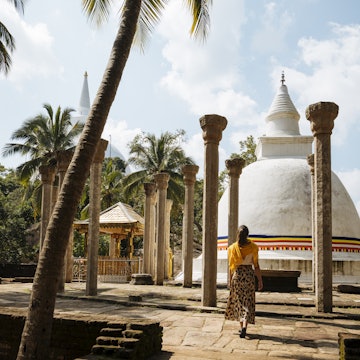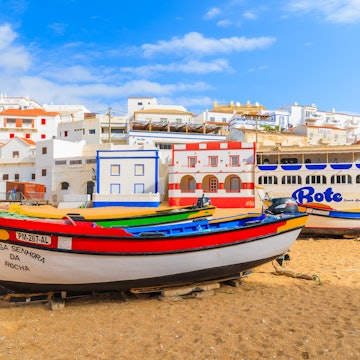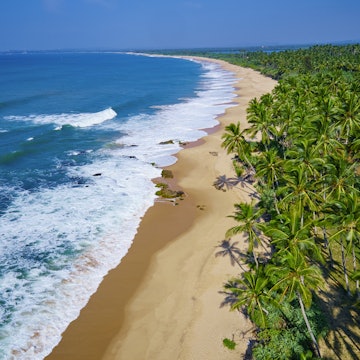

A tuk tuk outside Jami Ul-Alfar Mosque in Pettah, Colombo. Athikhom Saengchai/Shutterstock
While Sri Lanka is gaining popularity as a travel destination, the island’s executive and judicial capital, Colombo, doesn’t get the same love. It's still not on most people’s itineraries, but there are enough reasons why it should be.
The city is home to a blend of different cultures from across the island. It buzzes with homegrown chefs, bartenders, and entrepreneurs doing remarkable things with native produce. Think cocktails made with once-overlooked local spirits or alfresco brunches melding Thai and Sri Lankan flavors. And more than anything, Colombo is a great introduction to the island itself with well-preserved museums, galleries, seaside promenades, markets, temples, mosques, and colonial-era hospitals converted into shopping precincts.
A charming city by the Indian Ocean, Colombo’s coastline is flecked with gorgeous hotels with infinity pools. Take a stroll along the walkable streets that spill into leafy neighborhoods, and you’ll find boutique stays with character. Or use the city as a base to explore some of the country’s beach towns, adventure hubs and historical sites.

When should I go to Colombo?
Colombo is a year-round destination, with peak tourist season in December to April when the winds are cooler and the crisp blue skies bring crowds in numbers. Many tourists, though, tend to avoid Colombo entirely or only use the city as a pit stop, so it doesn’t really feel busy. Prices are at their highest during this period.
The city is hot, humid, and steamy throughout the year. And because it’s by the sea in the tropics, the weather in the capital, like elsewhere in Sri Lanka, can be unpredictable. May usually brings the first monsoonal rains, but with a changing climate, torrential downpours can arrive any time of the year. The good thing is that rain passes quickly and rarely gets in the way of your plans.
March and April are the hottest months of the year, with temperatures reaching the highs of 36°C (97°F) and humidity hovering around 80%. Mid-April is also the quietest period in Colombo when everyone heads out of the capital for Sinhala and Tamil New Year celebrations. But it's a lovely time to be around; the streets are calm and the rosy trumpet trees are in full bloom.

How much time should I spend in Colombo?
If you are visiting as part of a longer trip around Sri Lanka, two nights in Colombo is good enough to take in the city’s highlights. Consider heading to the Colombo National Museum, the Buddhist temple of Gangaramaya, the bustling Pettah Market, and the iconic Jami Ul-Alfar Mosque. If you are here on a Saturday morning, don't miss the Good Market where home bakers, boutique owners and artisans gather to sell their products.
Colombo can work well as a quick city break or as a good base to explore other parts of the country. With four to five days in the city, you’ll get to enjoy leisurely brunches at chic cafes, enjoy aappa (a bowl-shaped snack made of fermented rice batter) dinners, and visit art spaces like the Museum of Modern and Contemporary Art and Saskia Fernando Gallery. Then, take a day trip to the beach town of Bentota and head on a guided tour across Lunuganga, the country estate of the late architect Geoffrey Bawa. Other day trip options include white water rafting in Kitulgala or taking a two-hour drive south to see the UNESCO-listed, 300-year-old Galle Fort.

Is it easy to get in and around Colombo?
Most international flights to Sri Lanka land in Bandaranaike International Airport (BIA), which is a 35-minute drive north of Colombo's center. During the day, you can get the air-conditioned bus no 187 from the airport to Colombo’s main bus stand in Pettah for Rs 300 (US$1). From there, depending on where your accommodation is located, it’s better to hop in a taxi with ride-hailing apps, such as Uber or local alternative PickMe (both car and tuk tuk options are available). A direct taxi from the airport to Colombo costs Rs 4500–6000 (US$15–20).
Colombo’s center – if you don’t mind the sweltering heat and humidity – is quite walkable. Some neighborhoods, like the Cinnamon Gardens or Battaramulla, have massive trees lining the pathways. The Marine Drive runs for about 6.5km (4 miles) by the Indian Ocean – along the southern-bound railway – and is excellent for sunset walks. Colombo has a functional bus system, but buses are not air-conditioned and get quite crowded during peak hours. Stick to ride-hailing apps to get around and for day trips. If you are visiting Galle, you can hop on the train or an air-conditioned expressway bus from Makumbura (buses run every 20 minutes from dawn to dusk).
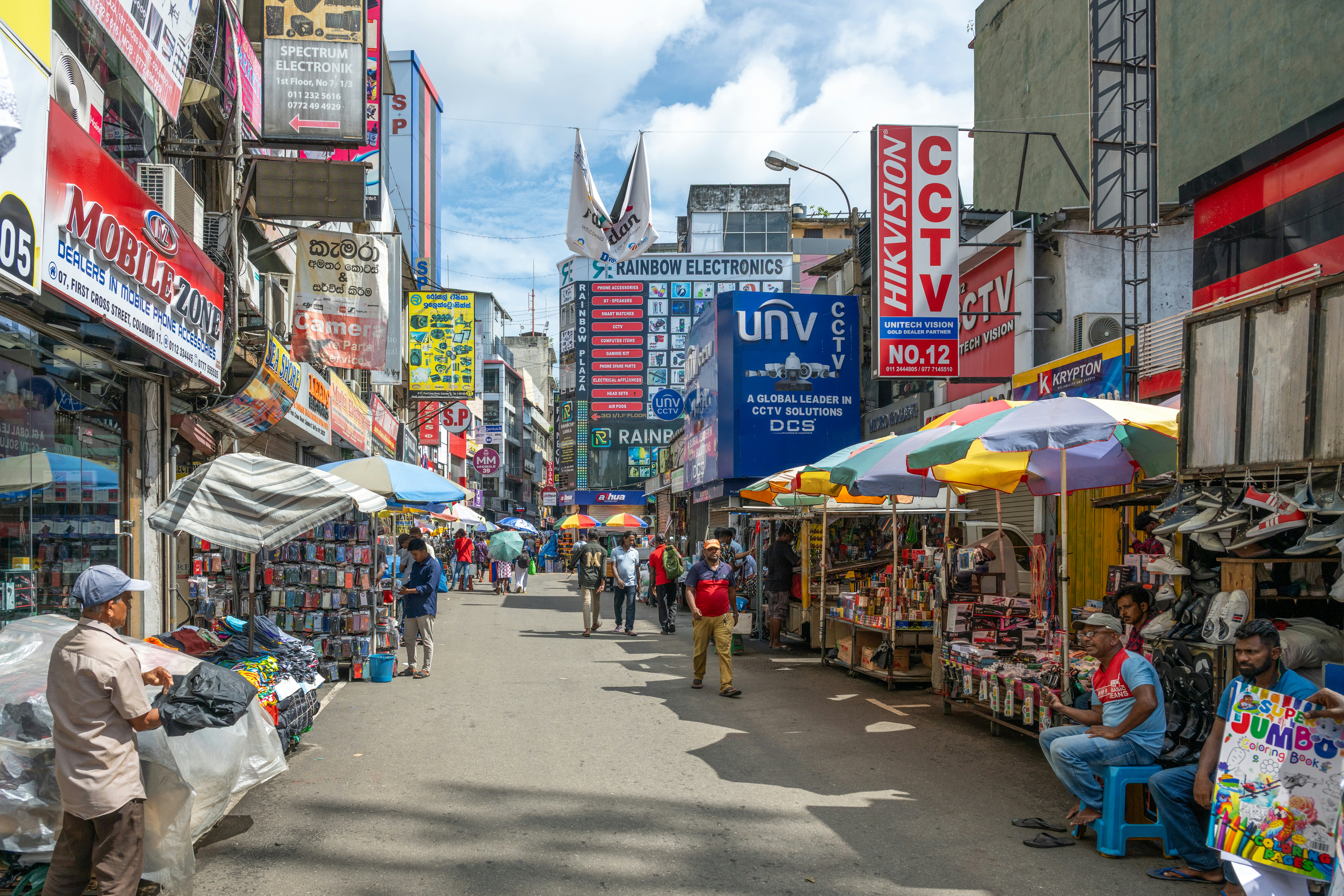
Top things to do in Colombo
Take a self-guided tour to Colombo’s busiest market
Hawkers, wooden carts and porters balancing towering crates weave through the jostling crowds. Streets are packed inch by inch, crammed with rows of pineapples, cluttered shelves of wedding cards, bundles of sequin-studded saris, stacks of gold bangles, and rows of knockoff designer luggage, phones, and fancy watches. This is Pettah, Colombo’s biggest marketplace. It’s loud, vibrant, and alive.
Pettah can feel chaotic, even for a local like me, but if you come with an open mind, you’ll find a place that bustles with Colombo’s daily life. You'll also walk away with cool collectibles like vintage leather belts, old phones, wallets, and weekender bags for nearly half the price elsewhere.
The market stretches across several streets, sidewalks and tiny alleyways, each dedicated to specific things, like wedding clothes, jewellery, glassware, lamps, electronics, shoes and snacks. Pettah's Main St specializes in clothes and houses the iconic Khan Clock Tower on the landscaped roundabout, built in the early 20th century by a wealthy trading family who migrated to the city from Mumbai. On Second Cross St is the famous 1909-built Jami Ul-Alfar Mosque, known as the Red Mosque for its striking red-and-white stripped design. Don’t miss the street carts selling pickled fruit, glass cabinets stacked with maalu paan (baked buns stuffed with a spicy filling of potato and canned tuna), and Mayura Hotel serving crab curry lunches on banana leaves.
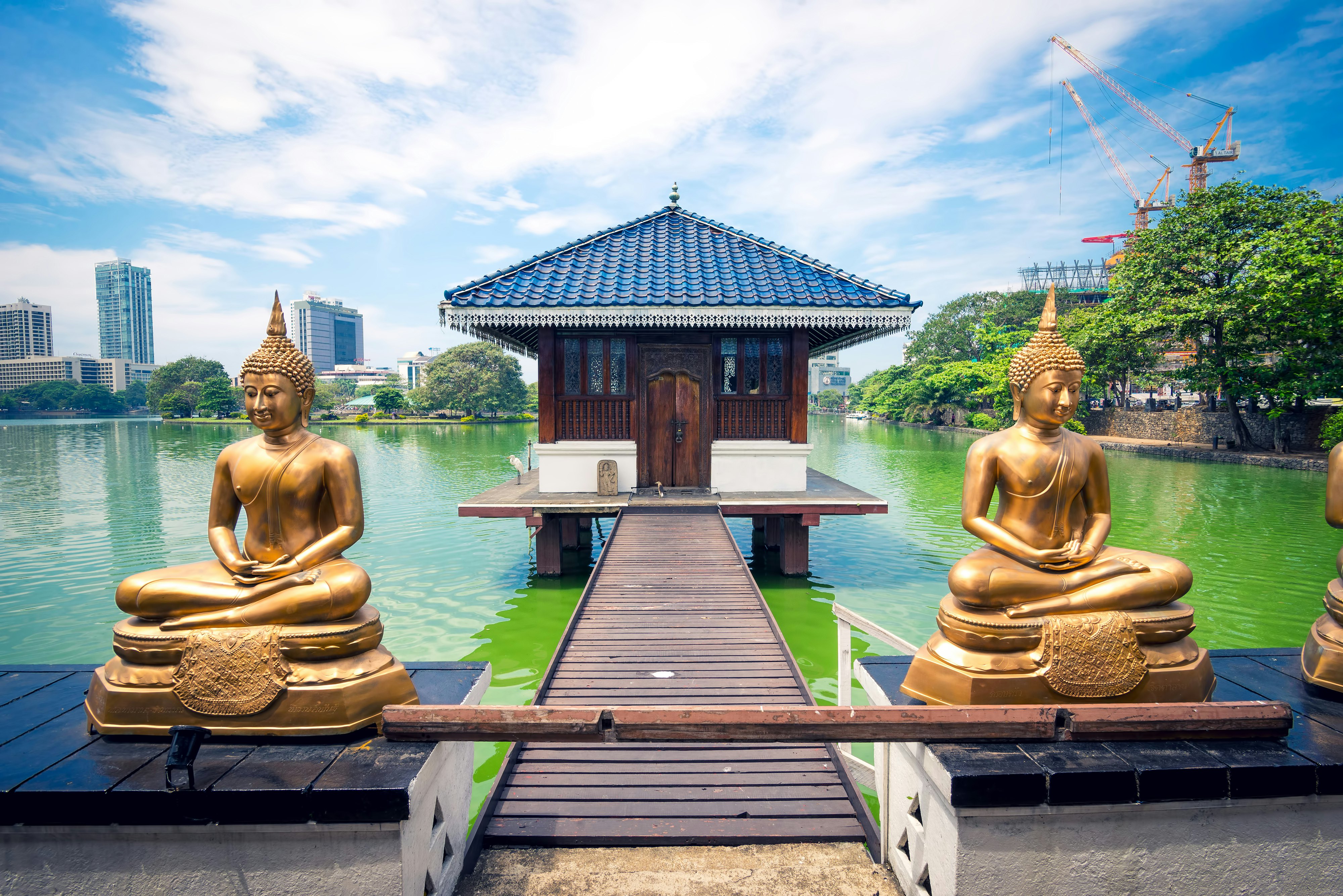
Dig into Geoffrey Bawa’s designs and architecture
The late Geoffrey Bawa is Sri Lanka’s most celebrated architect. And although he never used the term himself, he’s known as the pioneering figure of tropical modernism, an architectural style that responds to air, light and climate in tropical environments by combining open spaces, natural surroundings and local building knowledge. For the ultimate Bawa experience, your first stop is Number 11. A guided tour of Bawa’s urban residence takes you through a series of small rooms, passageways leading to courtyard gardens, patios, the architect’s own suite, and a large, private guest suite. During the walk, you'll also see: timber latticework garage doors hiding Bawa’s 1934 Rolls-Royce Drophead Coupe; terracotta-tiled seating rooms with antique wooden columns; tree roots outgrowing light wells; a large Balinese wall hanging; and Australian artist Donald Friend’s painted double doors.
Next on this self-guided Bawa-esque discovery is the Seema Malaka, a floating temple on the Beira Lake with a series of meditating Buddhas and a blue tiled roof, an excellent place to see how the architect uses his design principles in public spaces. To finish off, dress up for lunch or dinner at Gallery Cafe, Bawa's former office, now converted into a fine-dining restaurant with an alfresco courtyard and a water lily pond.
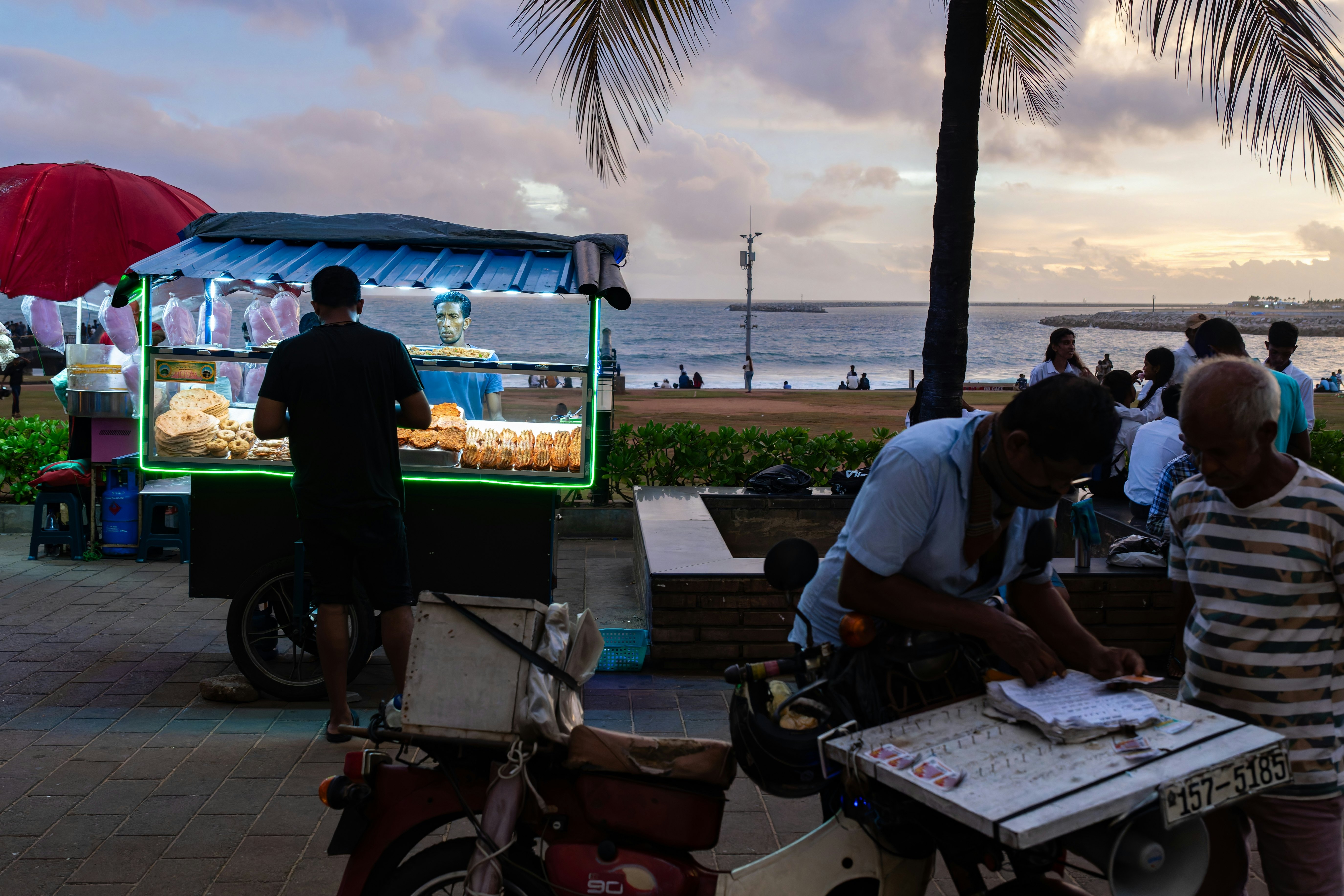
Savor the best of Sri Lankan cuisine
It’s easy to eat well in Sri Lanka if you know where to look for it. With abundance from the land and the sea along its 1340km-long (830-mile) coastline, you’ll find great food (like grilled mahi mahi, rice and curry served on lotus leaf, and boiled cassava with a spicy condiment) everywhere you go across the island. But if you want to really understand how different cultures and communities have influenced the island’s cuisine, Colombo is a great place for that.
Go for a vegetarian breakfast at Amirthaa (256A Galle Rd), which serves South Indian-influenced cuisine in one of Colombo’s Tamil-populated neighborhoods. For lunch, grab lamprais, which is rice, mixed meat curry, shrimp paste, ash plantain, eggplant, and small meatballs tightly assembled in a banana leaf and baked to elevate its flavor and aroma. Colombo’s VOC Cafe serves good lamprais and other dishes of the Dutch Burghers, descendants of Europeans who intermarried with Sinhalese and Tamils. Sri Lankan Moors, whose ancestry is tied to Arab traders, make their version of the biryani – called buriyani – available at Galle Caterers, or at Amma Nisa for a fancier experience. When my friends from Jaffna visit, they flock to Yarl for spicy, northern Sri Lankan-style crab curry and puttu (steamed, cylindrical ground rice and scraped coconut).

Explore Colombo’s parks
Colombo is a city built on a network of massive wetlands, and some of those are now turned into recreational parks and walking tracks. It’s the city’s way of bringing people closer to nature and preserving these spongy marshes that help Colombo breathe and protect itself from flooding. In the evenings, especially during the weekends, locals gather for tea or go for a jog at Diyatha Uyana and Urban Wetland Park in Nawala. My favorite, though, is the Beddagana Wetland Park with its native and migrant birdlife.
My favorite thing to do in Colombo
Although Colombo may not appear as an artsy hub, I absolutely love digging into everything art, design and craft-related in this city I call home. Sapumal Foundation is a thoughtful, well-kept treasure trove illustrating the work of the ‘43 Group, a 20th-century modern art collective. I love walking into the small rooms of this old residence that once belonged to painter Harry Pieris, where the walls now cover the work of the 20th-century Sri Lankan artists. I then take a 30-minute walk to Saskia Fernando Gallery, a small space housing paintings of contemporary artists. Every Saturday, my favorite Colombo market takes place in the city’s Racecourse. You can spend a couple of hours at the Good Market shopping for quilted bags, patchwork designs, handmade jewelry, and rattan furniture. Opposite, there’s Lakpahana, a selection of handicrafts and antiques.
Colombo’s art scene has always been elitist, but if there’s one place that’s moving away from this narrative, it’s the Museum of Modern and Contemporary Art. Housed inside the Crescat Boulevard shopping mall, I recommend everyone spend an hour or two at this modern gallery, which has rotating exhibitions with installations, short documentaries, curated tours and reading groups. It’s a place that aims to create a more inclusive and inspiring art scene, breaking down barriers of language, class and background across Sri Lanka.

How much money do I need for Colombo?
The good thing about Colombo is that it can cater to all budgets. But keep in mind that Colombo isn’t super cheap, especially not compared to its other South and Southeast Asian neighbors such as New Delhi, Kathmandu, Kuala Lumpur, or even Bangkok. Book well ahead or outside the main tourist season to get good deals on hotels. Generally, for accommodations, Colombo offers great value for money. If you are on a tight budget and staying at a hostel dorm, you can get by on Rs 15,000 (US$50) per person per day. Eat at low-key restaurants or holes-in-the-wall serving quick meals frequented by locals; you can find some flavorful rice and curry lunches or "shorties" (a range of savory and sweet Sri Lankan snacks) with a cup of frothy, sugary tea at these places for about Rs 600 (US$2).
Night at a five-star hotel: from Rs 60,000 (US$200)
Double room in a boutique hotel: from Rs 15,000 (US$50)
A cup of tea from a hole-in-the-wall: Rs 100 (US$0.30)
Cappuccino at a cafe: Rs 900 (US$3)
A 20-min, 7km (4-mile) Uber tuk tuk ride: Rs 600 (US$2)
A single bus fare: Rs 35 (US$0.12)
A can of 500ml local lager: Rs 480 (US$1.60)
Rice and curry lunch at a local restaurant: Rs 1000 (US$3)
High-end brunch with wine: from Rs 13,000 (US$43)
A dinner buffet at a luxury hotel: from Rs 8000 (US$26)
A Sri Lankan dinner at a fine-dining restaurant with non-alcoholic drinks: Rs 6000 (US$20)

Is Colombo Safe?
I’ve lived in Colombo for the last decade and I've never had to worry about my phone or wallet being snatched. Petty crime is generally rare, unless you venture into crowded places. Keep your belongings safe in busy marketplaces like Pettah. It’s also advisable to avoid walking at night if you are a solo female traveler.
Do I need to carry cash?
It’s common for Uber drivers to ask for “cash only” hires. Sometimes they may cancel your ride if you’ve opted for card payment. Small local restaurants, holes-in-the-wall, and street vendors only accept cash.
Can you drink the tap water in Colombo?
Many locals, including myself, drink the tap water. The water in most Sri Lankan cities is chlorinated, purified and regulated according to industry standards. However, if you aren’t used to it, it may make you ill, so grab bottled water or get boiled, filtered water.
What should I wear in Colombo?
Stay cool in Colombo by wearing anything easy, breezy, summery and loose. For some inexplicable reason, it’s very, very common to spot locals dressing up in tight denims, body-hugging shirts and synthetic fabrics. They are, however, extremely uncomfortable in the city’s heat and humidity. If you are entering a religious site, wear something that covers your knees and shoulders.








